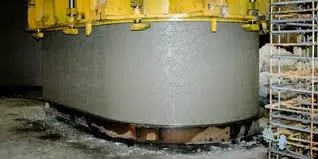nov. . 20, 2024 17:03 Back to list
spheroidal iron
Spheroidal Iron A Revolutionary Alloy for Modern Applications
Spheroidal iron, also known as ductile iron or nodular cast iron, has emerged as one of the most versatile and widely used materials in various industries. Since its development in the late 1940s by Keith Millis, spheroidal iron has transformed the landscape of metalworking and manufacturing due to its exceptional mechanical properties, corrosion resistance, and ease of machining.
Understanding Spheroidal Iron
Spheroidal iron is essentially a form of cast iron, but with a unique microstructure that consists of spherical graphite nodules instead of the flake graphite typically found in traditional cast iron. This spherical shape is key to its impressive ductility and toughness, which allow it to withstand greater stress and strain without fracturing. The production process of spheroidal iron involves the addition of elements such as magnesium or cerium to molten iron, promoting the formation of these nodules during solidification.
The process requires precise control during both the molten state and cooling, ensuring that the graphite takes on its desired spherical shape instead of forming flakes. The outcome is a material that combines the best properties of both cast iron and steel, thereby making it a prime choice in applications that demand high strength and durability.
Mechanical Properties
One of the standout features of spheroidal iron is its remarkable strength-to-weight ratio. This allows engineers to design lighter components without significantly compromising strength, which is a crucial factor in sectors such as automotive and aerospace. Furthermore, spheroidal iron offers excellent impact resistance and fatigue strength, making it ideal for components subjected to cyclic loads.
In addition to its mechanical durability, spheroidal iron exhibits superior wear resistance compared to traditional cast iron. This property is particularly beneficial in applications such as machinery parts, where friction and abrasion can significantly impair performance over time. The enhanced wear resistance translates into longer service life and reduced maintenance costs, making spheroidal iron an economically attractive option.
spheroidal iron

Applications Across Industries
The versatility of spheroidal iron means it finds use in numerous industries, including automotive, construction, and manufacturing. In the automotive sector, it is employed to manufacture components such as crankshafts, gears, and suspensions that require significant strength and resilience. The lightweight and durable nature of spheroidal iron contributes to improved fuel efficiency and performance in vehicles.
In the construction industry, spheroidal iron is increasingly being used for pipes and fittings, particularly for water and gas distribution systems. Its excellent corrosion resistance extends the lifespan of these infrastructure elements, reducing the need for costly repairs and replacements.
Manufacturers also utilize spheroidal iron in creating a variety of industrial machinery and tools. Its machinability makes it easy to work with, allowing for intricate designs and precise finishes. This quality, combined with its strength, makes it preferable for producing gears, bearings, and other critical machinery components.
Environmental Considerations
As industries strive to enhance sustainability, spheroidal iron presents an environmentally friendly option. The recycling process for cast iron, including spheroidal iron, is well-established, minimizing waste and promoting resource efficiency. Additionally, its durability means that products made from spheroidal iron can last significantly longer than those made from less resilient materials, ultimately leading to reduced material consumption and waste over time.
Conclusion
Spheroidal iron represents a remarkable achievement in materials engineering, exemplifying how innovation can yield materials that meet the demanding requirements of modern applications. Its unique properties, including high strength, wear resistance, and excellent machinability, have solidified its position as a go-to material across various industries. As the world continues to evolve and industries embrace new technologies and methodologies, spheroidal iron will undoubtedly play a pivotal role in shaping the future of manufacturing and engineering.
-
Durable Cast Steel Concrete Pipe Mold Bottom Rings & Base Trays
NewsAug.23,2025
-
Centrifugally Cast Iron Water Main Pipe for Reliable Mains
NewsAug.22,2025
-
Durable Centrifugally Cast Iron Water Main Pipe
NewsAug.11,2025
-
Centrifugally Cast Iron Water Main Pipes for Reliability
NewsAug.10,2025
-
High-Quality Centrifugally Cast Iron Water Main Pipes
NewsAug.09,2025
-
Durable Cast Iron Water Main Pipe & Drainage Solutions
NewsAug.08,2025


